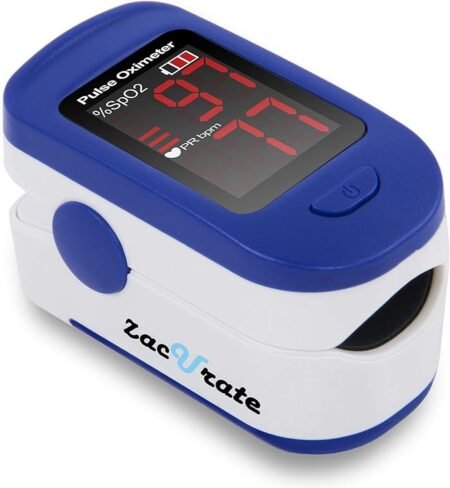
buy product
Introduction to Pulse Oximeters
Pulse oximeters are non-invasive devices designed to measure the oxygen saturation levels in the blood. These compact, easy-to-use tools are frequently clipped onto a finger to provide real-time readings, ultimately offering critical data for individuals managing various medical conditions. Originally developed in the 1970s, the technology behind pulse oximeters has become a staple in both home and clinical settings.
The working principle of a pulse oximeter involves the passage of light through the tissue to detect blood oxygen levels, specifically SpO2. The device projects two wavelengths of light—red and infrared—onto the skin and measures the absorption rates. Oxygenated and deoxygenated hemoglobin absorb light differently; by calculating the varying absorption at each wavelength, the pulse oximeter determines the percentage of oxygenated hemoglobin in the blood. This real-time measurement is presented as a percentage, typically ranging between 95% and 100% in healthy individuals.
The importance of pulse oximeters cannot be overstated, especially for people with chronic conditions such as Chronic Obstructive Pulmonary Disease (COPD), asthma, or those affected by acute respiratory infections like COVID-19. For these individuals, monitoring blood oxygen levels can be life-saving. A drop in SpO2 levels may signal the need for medical intervention, thereby helping to prevent severe complications or hospitalizations. By offering continuous non-invasive monitoring, these devices contribute significantly to patient safety and proactive health management.
Moreover, the affordability and user-friendly nature of modern pulse oximeters have made them accessible to a wider audience. This accessibility means that anyone, from athletes to the elderly, can benefit from regular monitoring. Understanding the history, functionality, and significance of pulse oximeters underscores their indispensable role in contemporary healthcare, ensuring that people across various demographics can maintain better control over their respiratory health.
How to Use a Pulse Oximeter Properly
Using a pulse oximeter correctly is essential to ensure that the readings you obtain are both accurate and reliable. Here is a step-by-step guide on how to use a pulse oximeter:
Step 1: Prepare Yourself
Before using the pulse oximeter, it is important to rest for at least five minutes in a comfortable position. This helps to stabilize your heart rate and blood pressure, facilitating a more accurate reading. Ensure that your hands are warm, as cold fingers can affect the accuracy of the measurement.
Step 2: Proper Fit and Placement
Select a fingertip that is clean and free from nail polish or artificial nails. Place the oximeter on the finger, ensuring that it fits snugly but not too tightly. A proper fit ensures the sensor can effectively measure the blood oxygen levels without being hindered by external factors.
Step 3: Stay Still
Once the pulse oximeter is in place, keep your hand still and at heart level. Movement can cause fluctuations in readings and potentially lead to inaccurate results. It is recommended to rest your hand on a flat surface to minimize movement.
Step 4: Wait for the Reading
The pulse oximeter will take a few seconds to stabilize and display the reading. During this time, continue to remain still and avoid talking or any other activity that could disrupt the measurement. Once the reading appears, note both the blood oxygen saturation level (SpO2) and pulse rate.
Common Mistakes to Avoid
To ensure accurate results, avoid common mistakes such as: using the device on a cold finger, having excess movement during the reading, and using the device on a finger with nail polish or artificial nails. Also, ensure that the device is properly calibrated for optimal performance.
By following these steps and avoiding common pitfalls, you can effectively use a pulse oximeter to monitor your blood oxygen levels with confidence.
Interpreting Pulse Oximeter Readings
Understanding your pulse oximeter readings is essential for monitoring your health effectively. The primary metrics that a pulse oximeter provides are the oxygen saturation percentage (SpO2) and the pulse rate. These numbers offer valuable insights into your respiratory and cardiovascular health.
The SpO2 represents the percentage of oxygen-saturated hemoglobin in your blood relative to the total hemoglobin available. A normal SpO2 reading for a healthy individual typically ranges from 95% to 100%. Levels below 90% are generally considered low and may indicate a condition known as hypoxemia, which warrants medical attention. It’s crucial to note that certain factors, such as altitude or chronic lung conditions, might affect what’s considered normal for a particular individual.
The pulse rate displayed on the pulse oximeter is measured in beats per minute (BPM). A normal resting pulse rate for adults generally ranges from 60 to 100 BPM. Athletic individuals may have lower resting pulse rates due to improved cardiovascular efficiency. Conversely, a consistently elevated pulse rate, known as tachycardia, or a significantly low pulse rate, known as bradycardia, can be indicative of underlying health issues and should be evaluated by a healthcare professional.
When interpreting your pulse oximeter readings, look for consistency and trends over time rather than isolated numbers. If you consistently observe SpO2 levels below 90% or experience symptoms such as shortness of breath, dizziness, or increased heart rate along with your readings, it’s advisable to seek medical advice. Both SpO2 and pulse rate provide critical information, but they should be considered alongside other symptoms and in the context of your overall health. Properly understanding and interpreting these readings can help you and your healthcare provider make informed decisions regarding your health management.
Limitations and Considerations
Pulse oximeters are widely used for monitoring blood oxygen levels, offering convenient and non-invasive measurement. However, they are not infallible and come with several limitations that can influence their accuracy. One notable factor is the presence of nail polish or artificial nails, which can obstruct the infrared light emitted by the device, leading to inaccurate readings. Dark-colored nail polish, in particular, is often cited as a significant impediment.
Additionally, skin pigmentation can affect the performance of pulse oximeters. Variations in melanin levels can alter how light is absorbed and reflected by the skin, potentially skewing the results. This necessitates caution when interpreting readings in individuals with darker skin tones, as the data may not always be reliable.
Peripheral circulation issues pose another challenge. Poor blood flow to the extremities can result in suboptimal sensor readings, thereby failing to accurately reflect systemic oxygen levels. Conditions such as cold extremities or peripheral vascular disease can further exacerbate these inaccuracies.
Given these potential pitfalls, it is crucial to understand that pulse oximeters should be utilized as complementary tools rather than definitive diagnostic instruments. While they offer valuable real-time insights into a person’s oxygen saturation, relying solely on pulse oximeter readings to assess health status can be misguided. Other diagnostic methods, including arterial blood gas analysis and clinical evaluations, should be employed to provide a comprehensive understanding of an individual’s health condition.
In essence, while pulse oximeters can be instrumental in monitoring oxygen levels, their limitations necessitate a cautious and informed approach. Healthcare providers and users alike must be aware of the factors that can influence readings and ensure that these devices are used in conjunction with other diagnostic tools to obtain an accurate assessment of a person’s health.
buy product
Discover more from detoatepentrutotisimaimult
Subscribe to get the latest posts sent to your email.
